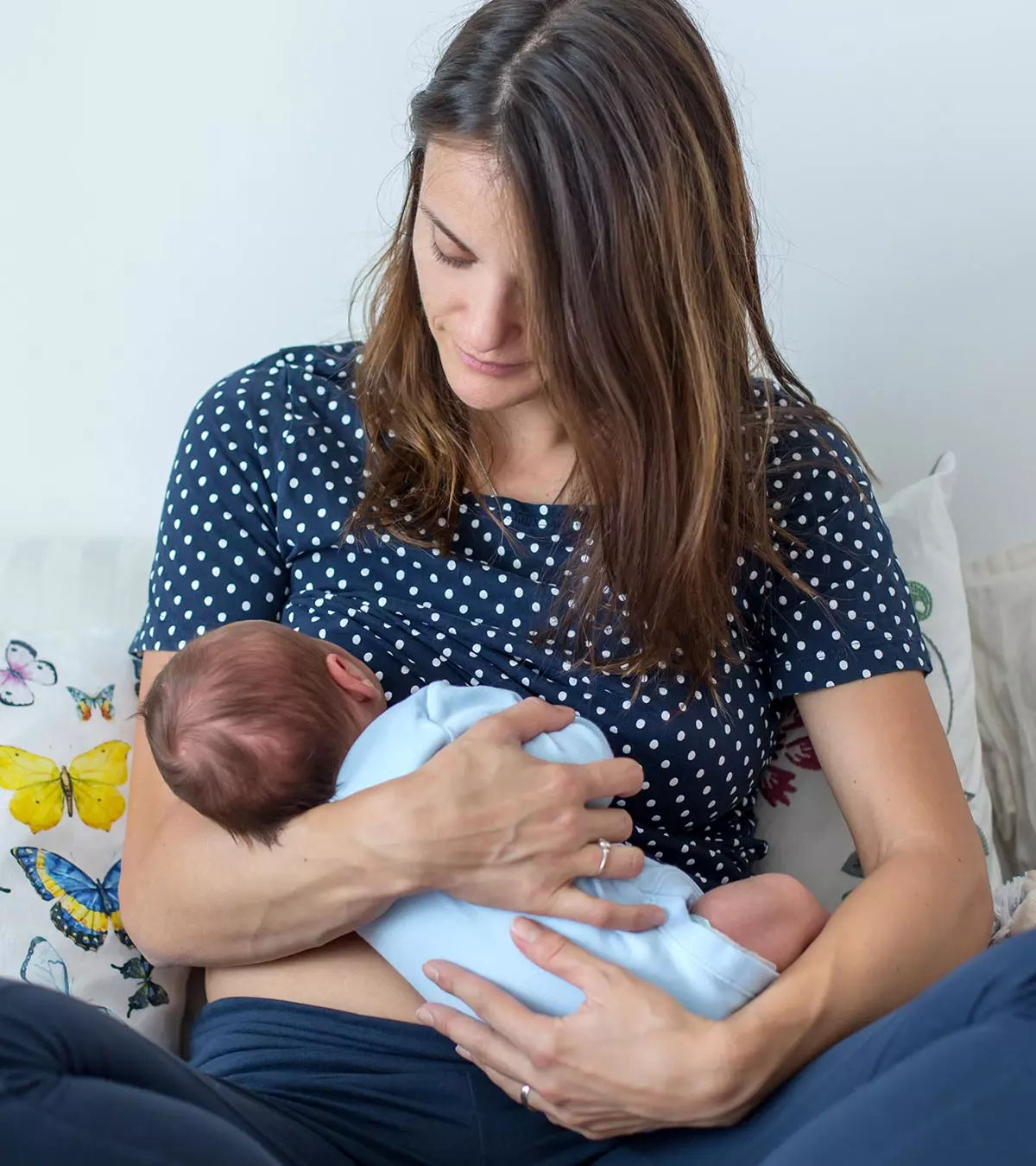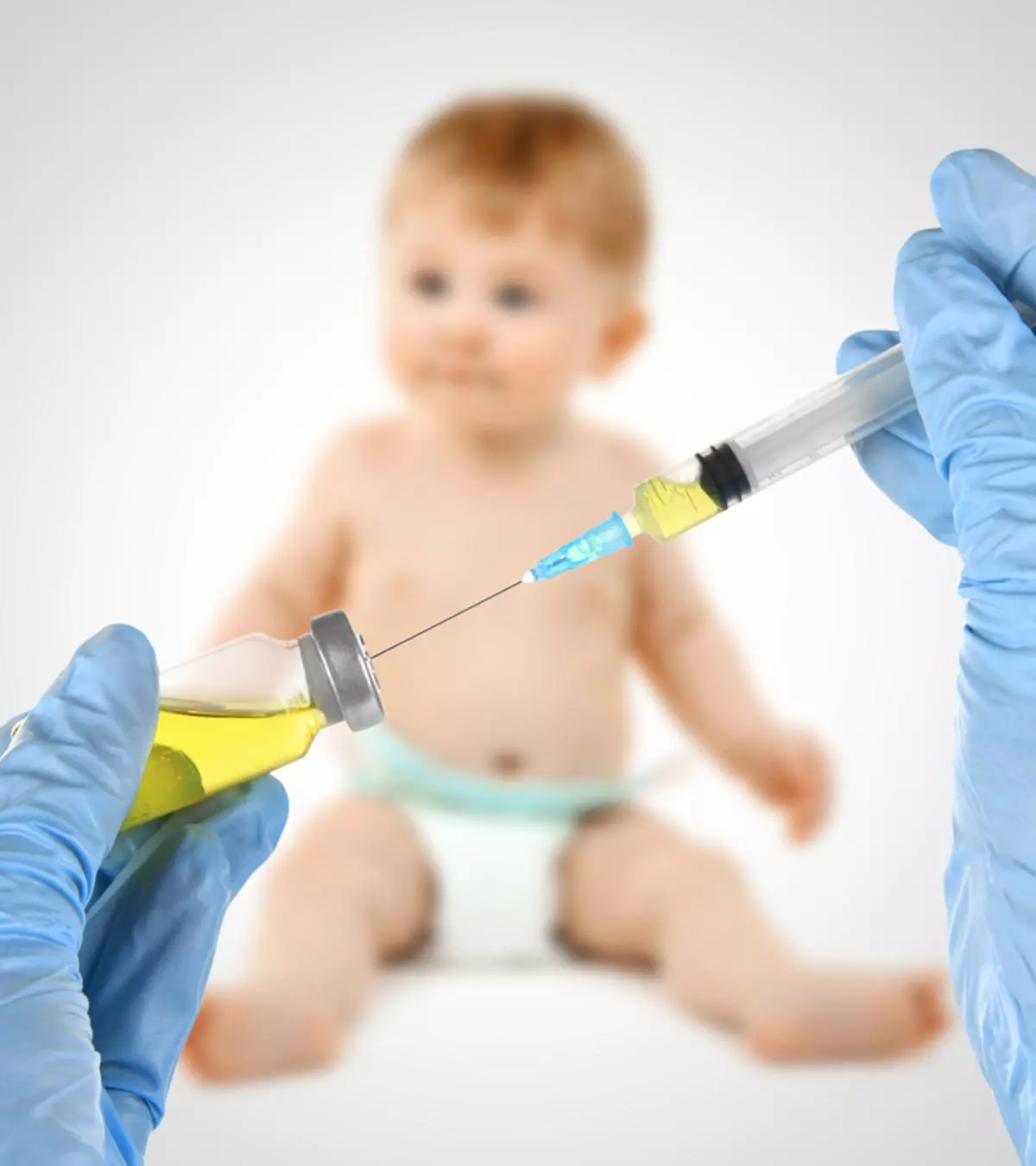
Image: Shutterstock
Pain after vaccination in babies is a common worry among parents. But that should not stop you from getting your baby vaccinated. The US Centers for Disease Control and Prevention (US CDC) states that immunization is extremely important for babies and can protect them from more than 14 serious childhood illnesses (1). According to the American Academy of Pediatrics (AAP), most childhood vaccines exhibit a 90% to 99% efficacy in preventing these diseases (2). The benefits of vaccines outweigh the minor discomfort caused by the pain. Managing pain after vaccination is crucial for your baby’s comfort and future healthcare experiences. Therefore, instead of skipping inoculation, try to find ways to reduce the pain. In this article, we discuss the possible after-effects of vaccination on your baby and tell you how you can help reduce pain.

Key Pointers
- Preparing the skin before the shot can help minimize discomfort by numbing and making the area less sensitive.
- Distracting the baby with toys, singing, or a pacifier during the shot can help to take their attention off the discomfort.
- Breastfeeding or providing the baby with a bottle before or after the shot can help calm the baby and relieve pain.
- Gently massaging or hugging the baby close might bring comfort and relieve pain.
- Acetaminophen or ibuprofen can assist in reducing swelling and discomfort post-vaccination.
How Painful Are Vaccinations For Babies
The pain babies experience from vaccinations can vary depending on the type of vaccine, where the shot is given, and how sensitive the baby is to pain. While all vaccines involve some discomfort, research suggests that certain vaccines may cause more pain than others. For example, a study showed that the Priorix vaccine resulted in less immediate pain compared to MMR-II in 18 to 24-month-old babies receiving measles, mumps, and rubella shots (3).
Some vaccines cause more pain because of their ingredients or how they are administered. Vaccines containing specific chemicals or preservatives can lead to stronger reactions, increasing discomfort (4). Additionally, larger volume injections and those given in the thigh are generally rated as more painful (5). A baby’s age, how they typically react, and their previous experiences with needles also affect the level of pain they feel (6) (7).
Tips To Manage The Pain After Vaccination For Babies
Pain is a common after-effect of vaccination. Minimizing pain can help make vaccination less intimidating and stressful both for the newborns or infants and the parents. Babies exhibit lesser fear of needles and fewer healthcare avoidance behaviors while growing up when the pain from vaccination is managed better (8).
The following are some suggested tips to manage the pain after vaccination in infants.
1. Give some quiet time
The baby might be irritated and exhausted due to crying after the vaccine. Put the baby in a comfortable, temperature-controlled, and quiet room. Dress them in loose, comfortable, breathable clothes.
2. Hold the baby

Hold the baby close to yourself during and after vaccination. The baby might get the feeling of safety and will be less distressed by your skin contact. The CDC recommends holding and comforting the baby during vaccination to prevent the baby from moving his/her limbs (9).
 Point to consider
Point to consider3. Touch and soothe the baby
A study determined the effect of physical interventions in babies to reduce pain after vaccination. It states, “Physical intervention of the 5 S’s (swaddling, side/stomach position, shushing, swinging, and sucking) provided decreased pain scores on a validated pain scale and decreased crying time among 2- and 4-month-old infants during routine vaccinations (10).” Hence, gentle touch and soothing techniques can help calm the baby and ease vaccination pain.
4. Distract the baby
Distraction is defined as the use of strategies to take an individual’s attention away from the procedure (8). A new toy, book, bubbles, or a simple game of peek-a-boo might help in distracting the baby, and making vaccination less stressful.
5. Breastfeed
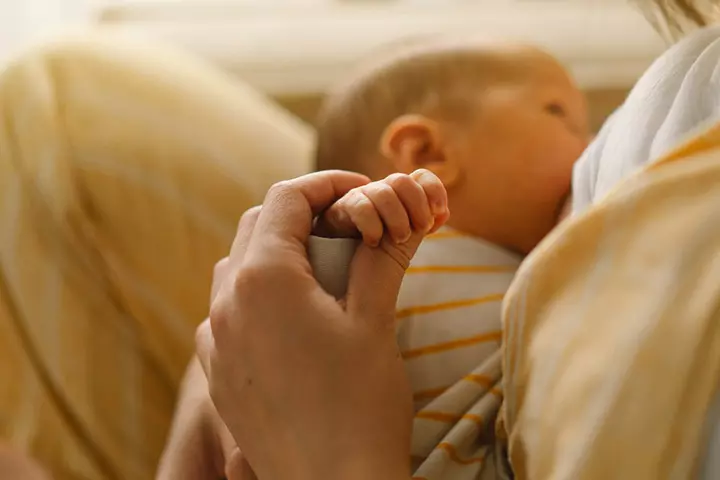
Breastfeeding before, during, and after vaccination may naturally help reduce pain and provide comfort. Breastfeeding is believed to have an analgesic effect on babies due to several reasons like skin-to-skin contact, the soothing effect of sucking, being held by the mother, and the sweet taste of breastmilk (11). The mother may start breastfeeding the baby before the injection is administered and continue doing it during the vaccination procedure as well. However, if the mother and the baby are not comfortable with this arrangement, then feeding pumped milk through a bottle or formula feeding might also work (8).
6. Give sweet-tasting solutions
Administering sweet-tasting solutions might help in distracting and calming the baby. Studies have shown that giving a few drops of a sweet solution before the procedure or giving a pacifier dipped in a sweet solution during the procedure, might ease the baby (11). However, this method is only recommended when the baby cannot be breastfed or formula-fed for some reason (8). Consult the doctor before choosing a sweet solution, like sugar syrup, for your baby. Never give honey to babies below the age of 12 months since it has the potential to cause gastrointestinal infection (12).
7. Apply cool pack
Applying cool packs of ice might help alleviate pain after vaccines (13). The application of a cool pack makes the skin numb and thus reduces pain at the site of injection. Remember, not all infants might be able to tolerate the coolness of ice and might cry when touched with an ice pack. Discuss it with your pediatrician before using any cool packs for your baby (8).
 Quick tip
Quick tip8. Give more liquids
If you are exclusively breastfeeding the baby, then continue doing the same after vaccination too. But if you have already started giving solids to the baby, then they might consume only liquid and eat less than usual for the first 24 hours (9). In such a case, you can consider feeding a liquid diet of purees, soups, and mashed food. Feed the baby whatever he/she is comfortable consuming for a day after vaccination.
9. Use topical anesthetics
Applying topical anesthetic agents might help in relieving pain from the vaccination. Topical anesthetics are available as rub-on gels as well as sprays (15). The gels might take an hour to show their effectiveness. Discuss with the pediatrician before using any over-the-counter (OTC) anesthetic agents (8).
10. Administer oral analgesics
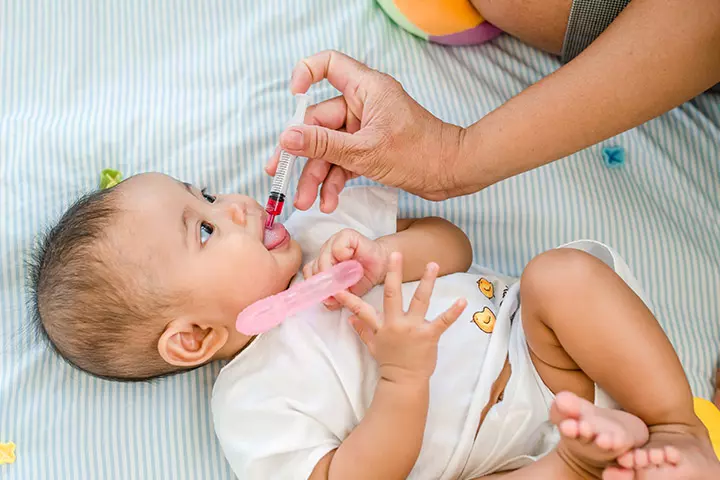
The doctors might prescribe medicines like acetaminophen or ibuprofen to manage pain after vaccination. However, these medicines are given after considering the baby’s weight, age, and general health. Do not give any over-the-counter (OTC) medicines to the baby without consulting the doctor (16).
 Did you know?
Did you know?Other Possible After-Effects Of Vaccination
The pediatrician usually informs what reactions to expect after administering a vaccine or a booster to the infant. The following are the common side effects of vaccinations (17) (18).
- Localized reactions like redness, swelling, and pain at the site of injection.
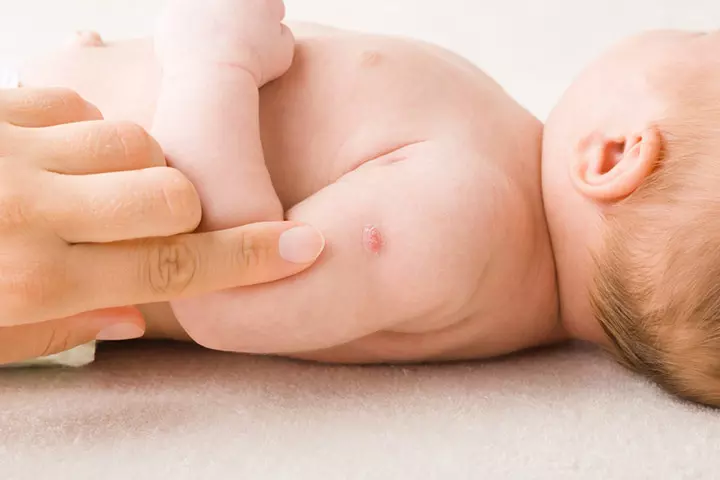
- Fever after vaccination in babies usually starts within 24 hours of vaccine administration and may last for one or two days.
- Babies may become fussy or more sleepy than usual after vaccination.
- Sometimes, a small, firm bump may appear at the injection site and stay for several weeks or months. This is normal and does not need any treatment.
- Delayed reactions of fever and rash after chickenpox and MMR shots. These reactions appear anytime between one to four weeks after taking the doses.
- Very rarely, severe anaphylactic reactionsiotentially life-threatening allergic reaction with symptoms such as difficulty breathing, hives, and facial/throat/tongue swelling to vaccines occur. They may start after two hours of vaccine administration. They need immediate medical attention. Contact the doctor immediately if your baby has persistent crying, breathing difficulties, behavior changes, full-body rashes, or other unusual signs after vaccination.
If you suspect anything unusual in your baby’s health after vaccination, then contact the doctor immediately.
Frequently Asked Questions
1. How long does vaccination pain last in babies?
All local reactions to vaccines like swelling, redness, and pain start within 24 hours of vaccine administration. They last for three to five days. Some vaccines, like DtaP, can cause pain that may last for up to seven days (17).
2. Can I give paracetamol before vaccination?
It is not generally recommended to use paracetamol for babies who are going to be vaccinated. However, if the baby develops severe distress due to fever or pain after vaccination, giving paracetamol may be recommended after vaccination.
3. Is it safe to give a bath to my baby after vaccination?
Yes, it is okay to bathe the baby after vaccination. Remember to be gentle while cleaning the area where the injection was administered. If the baby has a fever due to vaccines, then you can give a sponge bath instead (19).
4. Do babies sleep more after vaccinations?
Some studies have shown that babies sleep more for a day after they have been vaccinated. A study observed that babies showed an increase in sleep for 24 hours, especially when they were vaccinated in the afternoon, after 1:30 PM (20). However, the case can vary for each baby. If you find the baby to be extremely lethargic, dull, and sleepy after vaccination, then see the doctor.
5. Should babies born prematurely receive vaccines at the general recommended age?
Yes, babies who are born prematurely should receive all the vaccinations as per the normal baby vaccination schedule. Premature babies have a lower immunity as they receive fewer antibodies from the maternal placenta, and thus, must be vaccinated. If the baby weighs less than 2kg at birth, then vaccines like hepatitisiInflammatory condition of the liver caused by viral infections or other factors B might be given after the baby achieves a weight of 2kg (21).
6. Is it okay to delay vaccination for babies?
Dr. Andrea Wadley, MD, IBCLC, a physician and lactation consultant from Colleyville, Texas, says, “Vaccine schedules are based on the soonest possible time that it is safe to give a certain vaccine and at a time when the baby will need the most protection. Delaying the vaccine will put the baby at risk of getting the disease.”
7. What is the 6-in-1 vaccine for babies?
“The 6-in-1 vaccine contains six antigensiMolecules that can trigger an immune response in the body all in one vaccine. So, instead of getting several injections to become immunized against these diseases, VaxelisiA combination vaccine that protects against diphtheria, tetanus, pertussis, polio, Haemophilus influenzae type b, and hepatitis B allows us to give them all at once. It contains antigens to diphtheria, tetanus, pertussis, inactivated polio, haemophilus b conjugate, and hepatitis B all in one vaccine,” Dr. Wadley adds.
8. What is the earliest a baby may receive a vaccination?
It is advisable that your baby gets the initial shot of the vaccination shortly after being born. The hepatitis B vaccine should be given within 24 hours of birth (22).
These are a few tips you could take to reduce the discomfort caused by vaccination in babies. After the vaccination, dress your baby in comfortable clothing that wouldn’t rub on the injection site frequently. Caress your baby when in pain and try soothing techniques. Although the period immediately after vaccination might be stressful for you, understand that this is only temporary. As the days progress, the pain of vaccination would fade away, and your baby will start to feel relaxed. Also, keep a close eye on the baby after the injection and consult a doctor promptly if they show any concerning signs or adverse reactions.
Infographic: Tips For A Baby’s Vaccination
When scheduling your baby’s vaccination, knowing about things to carry will make the process hassle-free. Here is an infographic with valuable tips to help you plan your baby’s vaccination day efficiently. Illustration: Momjunction Design Team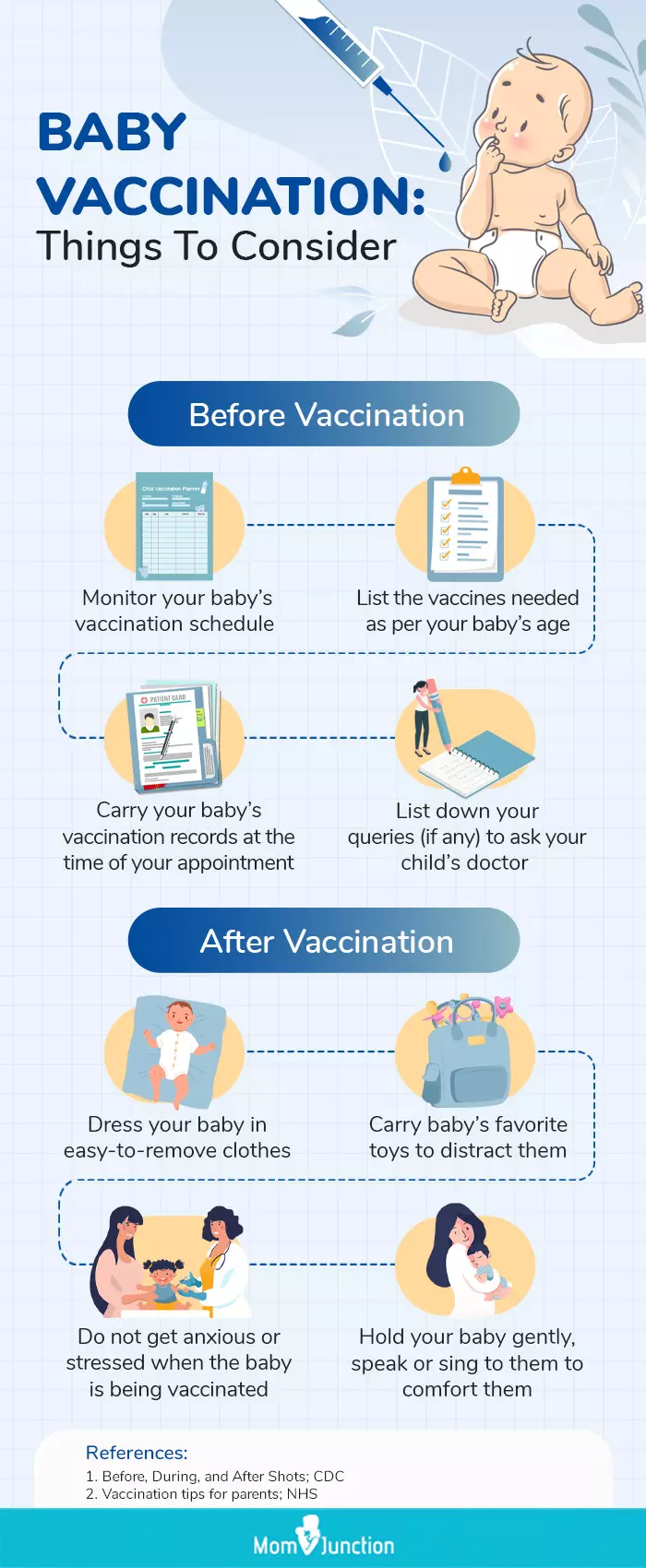
Illustration: Best Ways To Reduce Pain After Vaccination In Babies

Image: Dall·E/MomJunction Design Team
Your child must be vaccinated at the right time. Children may sometimes have reactions to vaccines which is a normal occurrence. Watch this video to learn about what to expect when your child is vaccinated and how vaccines work to protect them from disease.
References
- Reasons to Follow CDC’s Recommended Immunization Schedule.
https://www.cdc.gov/vaccines-children/schedules/reasons-to-follow.html - Vaccine Safety: Get the Facts.
https://www.healthychildren.org/English/safety-prevention/immunizations/Pages/Vaccine-Safety-The-Facts.aspx - Nina Knutsson et al; (2006); Immediate injection pain in infants aged 18 months during vaccination against measles, mumps and rubella with either Priorix® or MMR-II.
https://www.sciencedirect.com/science/article/abs/pii/S0264410X06005408 - Adjuvants and Vaccines.
https://www.cdc.gov/vaccine-safety/about/adjuvants.html - Eric Zijlstra et al; (2017); Impact of Injection Speed, Volume, and Site on Pain Sensation.
https://pmc.ncbi.nlm.nih.gov/articles/PMC5761988/ - Needle Pain in Children: Contextual Factors.
https://publications.aap.org/pediatrics/article-abstract/122/Supplement_3/S125/29507/Needle-Pain-in-Children-Contextual-Factors?redirectedFrom=fulltext - Tiina Jaaniste et al; (2007); Factors associated with infant pain response following an immunization injection.
https://www.researchgate.net/publication/6868474_Factors_associated_with_infant_pain_response_following_an_immunization_injection - Anna Taddio et al; (2010); Reducing the pain of childhood vaccination: an evidence-based clinical practice guideline.
https://pmc.ncbi.nlm.nih.gov/articles/PMC3001531/ - How to Hold Your Child During Vaccination.
https://www.cdc.gov/vaccines-children/before-during-after-shots/how-to-hold-your-child.html - John W Harrington et al; (2012); Effective analgesia using physical interventions for infant immunizations.
https://pubmed.ncbi.nlm.nih.gov/22508924/ - Ricardo Carbajal et al; (2003); Analgesic effect of breast feeding in term neonates: randomised controlled trial.
https://pmc.ncbi.nlm.nih.gov/articles/PMC139493/ - Botulism.
https://www.who.int/news-room/fact-sheets/detail/botulism - Babies and shots.
https://medlineplus.gov/ency/article/001967.htm - Before, During, and After Shots.
https://www.cdc.gov/vaccines-children/before-during-after-shots/index.html - Make Shots Less Stressful for Your Child.
https://www.cdc.gov/vaccines-children/before-during-after-shots/less-stress.html - After the Shots.
https://www.immunize.org/wp-content/uploads/catg.d/p4015.pdf - Immunization Reactions.
https://www.seattlechildrens.org/conditions/a-z/immunization-reactions/ - Immunisation – side effects.
https://www.betterhealth.vic.gov.au/health/healthyliving/immunisation-side-effects - My baby has some redness and pus on BCG injection site. How could I take care of this condition?
https://www.fhs.gov.hk/english/health_info/faq/child_health/Imm1_5_3.html - Linda Franck et al; (2011); Infant Sleep After Immunization: Randomized Controlled Trial of Prophylactic Acetaminophen.
https://pmc.ncbi.nlm.nih.gov/articles/PMC3387894/ - Arnaud Gagneur et al; (2015); Immunization of preterm infants.
https://pmc.ncbi.nlm.nih.gov/articles/PMC4685684/ - Vaccines by Age.
https://www.cdc.gov/vaccines/by-age/?CDC_AAref_Val=https://www.cdc.gov/vaccines/parents/by-age/newborn-birth.html
Community Experiences
Join the conversation and become a part of our nurturing community! Share your stories, experiences, and insights to connect with fellow parents.
Read full bio of Dr. Nikolina Zdraveska
- Dr. Andrea Wadley is the owner and head pediatrician at 127 Pediatrics, a home visit-only direct primary care pediatric and lactation practice based in the Dallas/Fort Worth area of Texas. She graduated with a medical degree in 2007 from the University of Texas Health Science Center in San Antonio and did his residency at the same university.
 Dr. Andrea Wadley is the owner and head pediatrician at 127 Pediatrics, a home visit-only direct primary care pediatric and lactation practice based in the Dallas/Fort Worth area of Texas. She graduated with a medical degree in 2007 from the University of Texas Health Science Center in San Antonio and did his residency at the same university.
Dr. Andrea Wadley is the owner and head pediatrician at 127 Pediatrics, a home visit-only direct primary care pediatric and lactation practice based in the Dallas/Fort Worth area of Texas. She graduated with a medical degree in 2007 from the University of Texas Health Science Center in San Antonio and did his residency at the same university.
Read full bio of Dr. Ritika Shah
Read full bio of Rohit Garoo
Read full bio of Shinta Liz Sunny












